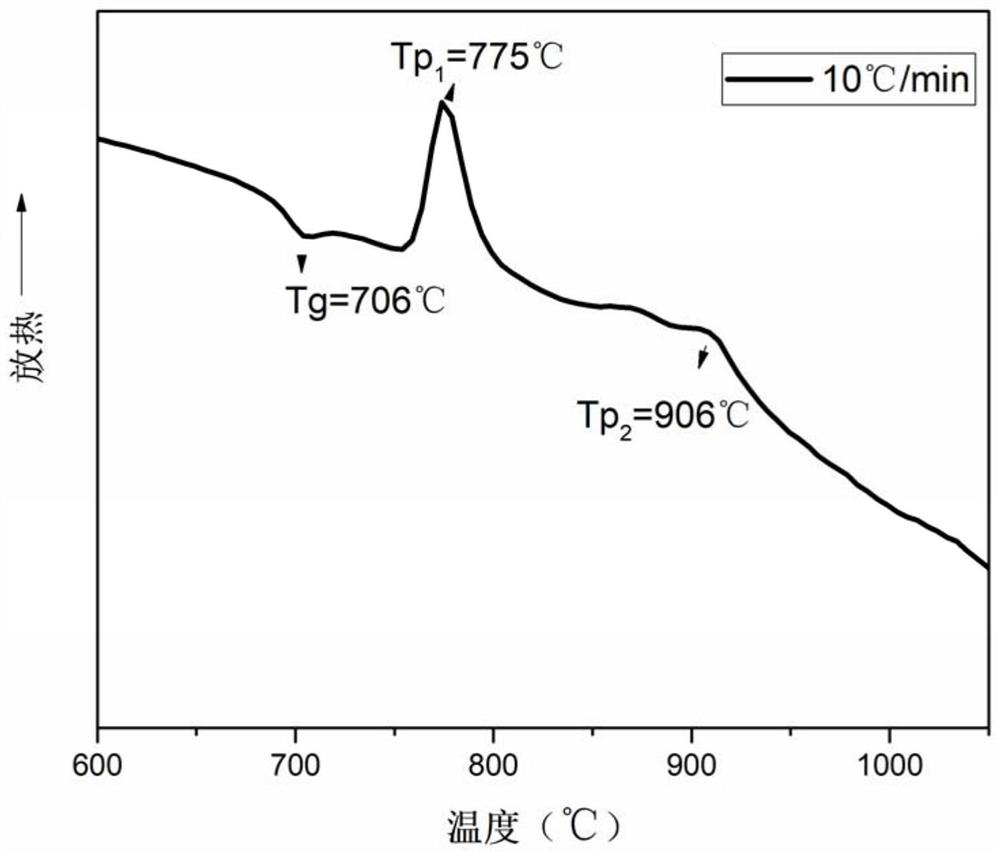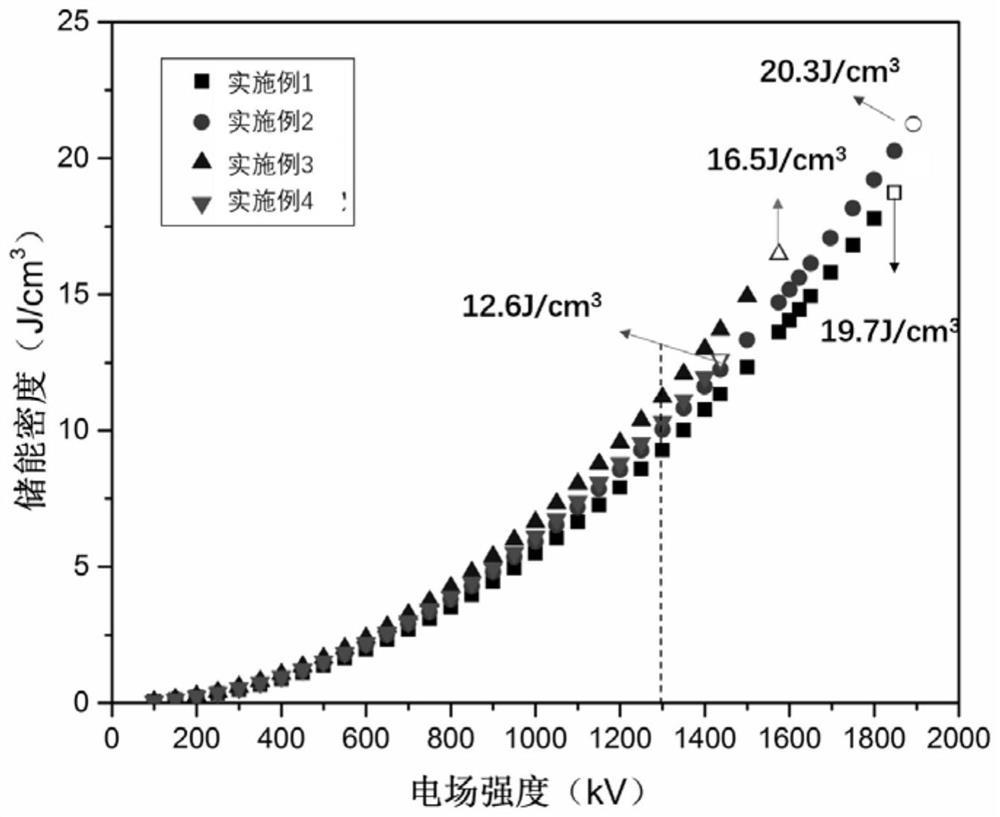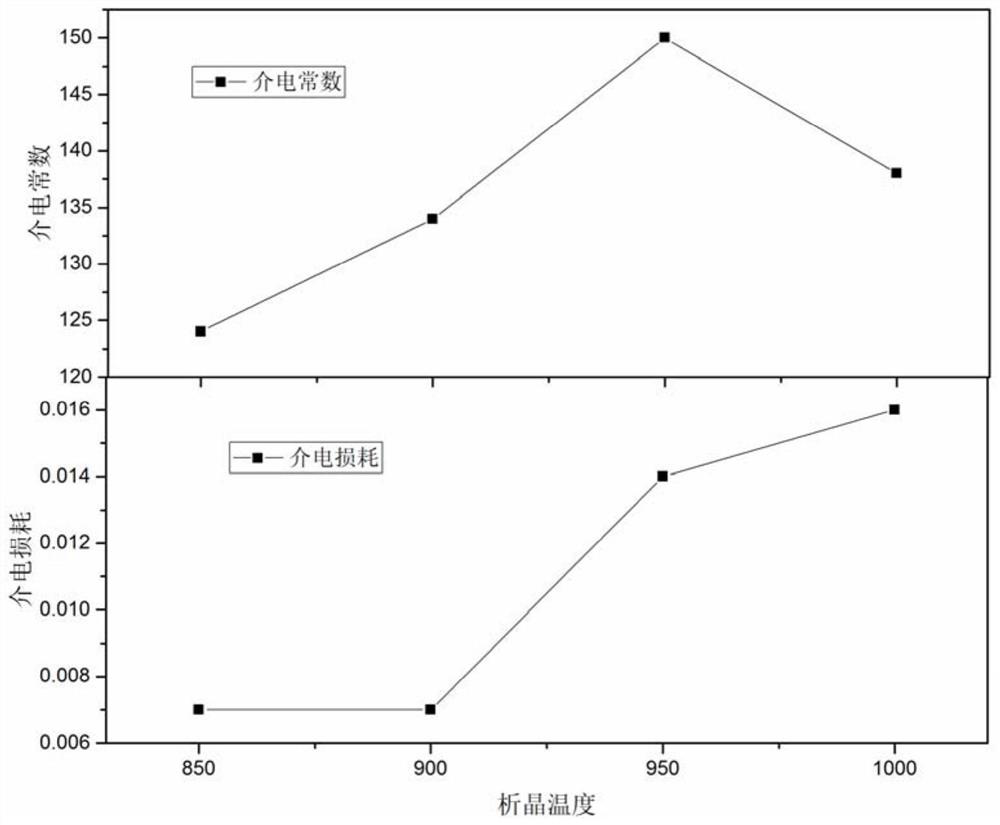Barium-lead-sodium niobate-based glass-ceramic material with high energy storage density and preparation method thereof
A high energy storage density, glass-ceramic technology, applied in glass manufacturing equipment, glass molding, manufacturing tools, etc., can solve the problems of unfavorable capacitor capacitance, material aging, etc., achieve uniform and dense microscopic appearance, increase content, The effect of uniform and dense microscopic morphology
- Summary
- Abstract
- Description
- Claims
- Application Information
AI Technical Summary
Problems solved by technology
Method used
Image
Examples
Embodiment 1
[0032] A method for preparing a barium-lead-sodium niobate-based glass-ceramic energy storage material with high energy storage density, comprising the following steps:
[0033] (1) Na with a purity greater than 99wt% 2 CO 3 、BaCO 3 , PbO, Nb 2 o 5 , SiO 2 For raw material ingredients, the molar percentage of each component is 6.4%, 23.04%, 2.56%, 32%, 36%, mixed by ball mill for 24 hours, dried at 120°C for 6 hours, then melted at 1500°C for 30 minutes; (The above-mentioned ball mills all use absolute ethanol as the medium, and the ball-to-material ratio is 1.5:1).
[0034] (2) Pouring the high-temperature melt obtained in step (1) into a square copper mold, annealing for stress relief at 600° C. for 6 hours, and then cutting to obtain glass flakes with a thickness of 1.0 to 1.5 mm;
[0035] (3) Put an equal amount of the glass flakes prepared in step (2) into a square crucible, heat up to 850°C at a rate of 5°C / min, and keep warm for 5 hours to obtain glass ceramics. ...
Embodiment 2
[0039] A method for preparing a barium-lead-sodium niobate-based glass-ceramic energy storage material with high energy storage density, comprising the following steps:
[0040] (1) Na with a purity greater than 99wt% 2 CO 3 、BaCO 3 , PbO, Nb 2 o 5 , SiO 2 For raw material ingredients, the molar percentage of each component is 6.4%, 23.04%, 2.56%, 32%, 36%, mixed by ball mill for 24 hours, dried at 120°C for 6 hours, then melted at 1500°C for 30 minutes; (The above-mentioned ball mills all use absolute ethanol as the medium, and the ball-to-material ratio is 1.5:1).
[0041] (2) Pouring the high-temperature melt obtained in step (1) into a square copper mold, annealing for stress relief at 600° C. for 6 hours, and then cutting to obtain glass flakes with a thickness of 1.0 to 1.5 mm;
[0042] (3) Put an equal number of glass flakes prepared in step (2) into a square crucible, heat up to 900°C at a rate of 5°C / min, and keep warm for 5 hours to obtain glass ceramics.
[0...
Embodiment 3
[0046] A method for preparing a barium-lead-sodium niobate-based glass-ceramic energy storage material with high energy storage density, comprising the following steps:
[0047] (1) Na with a purity greater than 99wt% 2 CO 3 、BaCO 3 , PbO, Nb 2 o 5 , SiO 2 For raw material ingredients, the molar percentage of each component is 6.4%, 23.04%, 2.56%, 32%, 36%, mixed by ball mill for 24 hours, dried at 120°C for 6 hours, then melted at 1500°C for 30 minutes; (The above-mentioned ball mills all use absolute ethanol as the medium, and the ball-to-material ratio is 1.5:1).
[0048] (2) Pouring the high-temperature melt obtained in step (1) into a square copper mold, annealing for stress relief at 600° C. for 6 hours, and then cutting to obtain glass flakes with a thickness of 1.0 to 1.5 mm;
[0049](3) Put an equal amount of the glass flakes prepared in step (2) into a square crucible, heat up to 950°C at a rate of 5°C / min, and keep warm for 5 hours to obtain glass ceramics.
...
PUM
| Property | Measurement | Unit |
|---|---|---|
| crystallization temperature | aaaaa | aaaaa |
| breakdown field strength | aaaaa | aaaaa |
| remanent polarization | aaaaa | aaaaa |
Abstract
Description
Claims
Application Information
 Login to View More
Login to View More - R&D
- Intellectual Property
- Life Sciences
- Materials
- Tech Scout
- Unparalleled Data Quality
- Higher Quality Content
- 60% Fewer Hallucinations
Browse by: Latest US Patents, China's latest patents, Technical Efficacy Thesaurus, Application Domain, Technology Topic, Popular Technical Reports.
© 2025 PatSnap. All rights reserved.Legal|Privacy policy|Modern Slavery Act Transparency Statement|Sitemap|About US| Contact US: help@patsnap.com



